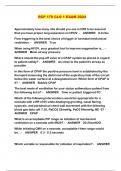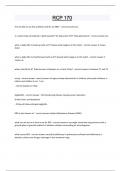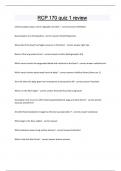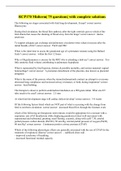Rcp 170 - Study guides, Class notes & Summaries
Looking for the best study guides, study notes and summaries about Rcp 170? On this page you'll find 35 study documents about Rcp 170.
Page 2 out of 35 results
Sort by
RCP 170 CLO 1 EXAM 2024...
RCP 170 Questions and answers latest update
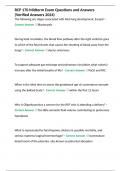
-
RCP 170 Midterm, review and final Exam Questions Package deal 2024
- Package deal • 4 items • 2023
-
- $28.49
- + learn more
Exam (elaborations) RCP 170 Midterm Exam Questions and Answers (Verified Answers 2024) 2 Exam (elaborations) RCP 160 Final Review Exam Questions and Answers (Verified Answers) Latest Update 2025 3 Exam (elaborations) RCP 160 CLO review Exam Questions and Answers (Latest Update 2024) 4 Exam (elaborations) RCP160 MIDTERM REVIEW Exam Questions and
RCP 170 quiz 1 review Questions and answers latest update
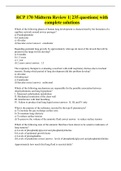
-
RCP 170 Midterm Review 1| 235 questions| with complete solutions
- Exam (elaborations) • 41 pages • 2023
- Available in package deal
-
- $14.99
- + learn more
Which of the following phases of human lung development is characterized by the formation of a capillary network around airway passages? a) Pseudoglandular b) Canalicular c) Alveolar d) Saccular correct answer: canalicular Regarding postnatal lung growth, by approximately what age do most of the alveoli that will be present in the lungs for life develop? a) 6 months b) 1.5 years c) 1 year d) 2 years correct answer: 1.5 The respiratory therapist is evaluating a newborn with mild r...
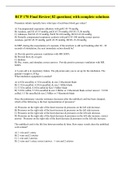
-
RCP 170 Final Review| 82 questions| with complete solutions
- Exam (elaborations) • 17 pages • 2023
- Available in package deal
-
- $12.99
- + learn more
Premature infants typically have what type of acid-base blood gas values? A) Uncompensated respiratory alkalosis with paO2 45-70 mmHg B) Acidosis, paCO2 45-55 mmHg, paO2 45-70 mmHg, HCO3-15-20 mmHg C) Alkalosis, PaCO2 25-35 mmHg, PaO2 50-100 mmHg, HCO3-22-28 mmHg D) Partially compensated respiratory acidosis with paO2 45-100 mmHg correct answer: Acidosis, paCO2 45-55 mmHg, paO2 45-70 mmHg, HCO3-15-20 mmHg In NRP, during the resuscitation of a neonate, if the newborn is still not breath...
RCP 170 TESTS COMPILATION BUNDLE
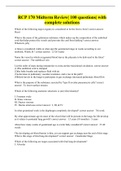
-
RCP 170 Midterm Review| 100 questions| with complete solutions
- Exam (elaborations) • 10 pages • 2023
- Available in package deal
-
- $12.99
- + learn more
Which of the following major organ(s) is considered to be the first to form? correct answer: Heart What is the name of the gelatinous substance which makes up the composition of the umbilical cord that helps protect the vessels and prevents the cord from kinking? correct answer: Wharton's jelly A fetus is considered viable at what specific gestational range in weeks according to our textbook, Walsh, B.? correct answer: 22-26 weeks Name the vessel in which oxygenated blood leaves the...
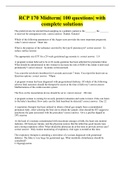
-
RCP 170 Midterm| 100 questions| with complete solutions
- Exam (elaborations) • 9 pages • 2023
- Available in package deal
-
- $12.49
- + learn more
The preferred site for arterial blood sampling in a pediatric patient is the ________, the _______ is reserved for emergencies only. correct answer: Radial, Femoral Which of the following parameters of the Apgar score provides the most important prognostic value? correct answer: Heart rate What is the purpose of the substance secreted by the type II pneumocyte? correct answer: To reduce surface tension The appropriate size ETT for a 29 week gestational age neonate is: correct answer:...
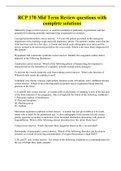
-
RCP 170 Mid Term Review questions with complete solutions
- Exam (elaborations) • 7 pages • 2023
- Available in package deal
-
- $12.49
- + learn more
Sildenafil (Viagra) correct answer: is used for treatment of pulmonary hypertension and has potential for reducing mortality and improving oxygenation in neonates. Laryngotracheobronchitis correct answer: A 4-year-old patient presented in the emergency department with a barking cough and mild inspiratory stridor. The patient's mother states that the child has been sick for a few days. A frontal and lateral neck radiographs were taken and the airway seemed to be narrowed just below the voca...

Do you wonder why so many students wear nice clothes, have money to spare and enjoy tons of free time? Well, they sell on Stuvia! Imagine your study notes being downloaded a dozen times for $15 each. Every. Single. Day. Discover all about earning on Stuvia

